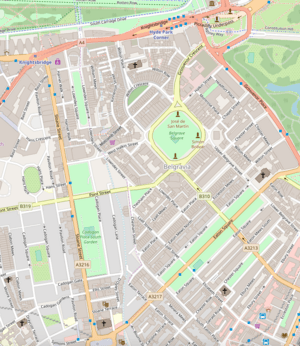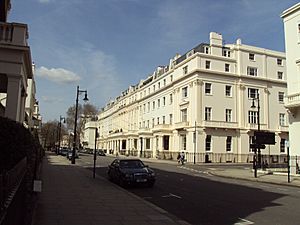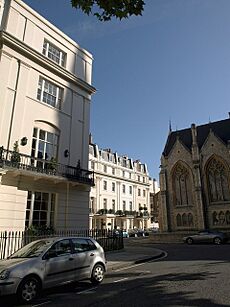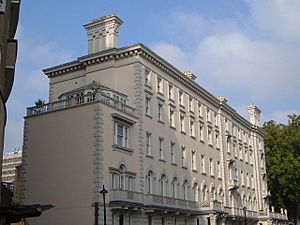Belgravia facts for kids
Quick facts for kids Belgravia |
|
|---|---|
 Chester Square, Belgravia, in March 2009 |
|
| OS grid reference | TQ275795 |
| London borough | |
| Ceremonial county | Greater London |
| Region | |
| Country | England |
| Sovereign state | United Kingdom |
| Post town | LONDON |
| Postcode district | SW1X, SW1W |
| Dialling code | 020 |
| Police | Metropolitan |
| Fire | London |
| Ambulance | London |
| EU Parliament | London |
| UK Parliament |
|
| London Assembly | |
Belgravia (/bɛlˈɡreɪviə/) is a fancy area in Central London. It is known for its beautiful, grand houses. This district covers parts of two London areas: the City of Westminster and the Royal Borough of Kensington and Chelsea.
Long ago, Belgravia was called the 'Five Fields'. It was a dangerous place with highwaymen (robbers on horseback) and many thefts. In the early 1800s, a wealthy family, the Grosvenors, decided to develop the area. Richard Grosvenor, 2nd Marquess of Westminster, with help from Thomas Cubitt, built many grand houses. These homes were centered around large squares like Belgrave Square and Eaton Square. Today, much of Belgravia is still owned by the Grosvenor family's property company, the Duke of Westminster's Grosvenor Group.
Contents
Exploring Belgravia: Where is it?
Belgravia is located near a small river called the River Westbourne. This river is a branch of the famous River Thames. Most of Belgravia is in the City of Westminster. A smaller part of it is in the Royal Borough of Kensington and Chelsea.
The area is mostly to the southwest of Buckingham Palace. It is surrounded by several main roads and other famous London areas. To the north, you'll find Hyde Park. To the east are Mayfair and Green Park. Westminster is also to the east.
Belgravia is mainly a place where people live. The main exceptions are the large squares like Belgrave Square and Eaton Square. These squares have beautiful gardens in their centers.
You can easily get to Belgravia using public transport. The closest London Underground stations are Hyde Park Corner, Knightsbridge, and Sloane Square. Victoria station is also nearby. It is a major hub for trains, the tube, and coaches. Many buses run through Belgravia, connecting it to other parts of Central London.
Belgravia's Past: A Look Back
Belgravia gets its name from a village called Belgrave, Cheshire. This village is close to the Grosvenor family's main country home, Eaton Hall. One of the Duke of Westminster's titles is Viscount Belgrave.
From Fields to Grand Homes
During the Middle Ages, this area was known as the Five Fields. It was a series of open fields where animals grazed. Footpaths crossed these fields. A bridge over the Westbourne river was called Bloody Bridge. It got this name because it was a dangerous place. Robbers and highwaymen often waited there. It was not safe to cross the fields at night. People even used the fields for duelling (fights with weapons).
Despite its dangerous reputation, the Five Fields were pleasant during the day. Many market gardens grew fresh produce there. Building began after King George III moved to Buckingham House. In 1826, Richard Grosvenor, 2nd Marquess of Westminster, got permission to build on the land. He worked with Thomas Cubitt to design the new estate.
The construction of the grand houses took place between 1830 and 1847. These homes are famous for their white stucco (a type of plaster) exteriors. The area quickly became one of London's most fashionable places to live.
Belgravia After World War II
After World War II, some of the largest houses changed their use. They were no longer just homes for wealthy families. Instead, many became embassies, offices for charities, or headquarters for businesses.
Today, Belgravia is a relatively quiet area in the heart of London. It is different from its busy neighbors, which have many shops and hotels. Many embassies are still located here, especially in Belgrave Square.
In the early 2000s, some of these old office buildings started becoming homes again. This is because many very rich people want to live in London. Houses in Belgravia are among the most expensive in the world. Some can cost tens of millions of pounds. Many of these properties are owned by wealthy people from other countries. This means some houses might be empty for parts of the year.
Famous Squares and Streets
Belgravia is known for its beautiful squares and wide streets.
Belgrave Square
Belgrave Square is one of the grandest squares in Belgravia. It was designed by Thomas Cubitt for the Grosvenor family. Building started in 1826 and was mostly finished by the 1840s.
The square has four main sections of grand white stucco houses. There are also large mansions in three of the corners. In the center is a private garden. The houses are numbered around the square. One of the largest corner mansions, Seaford House, was designed by Philip Hardwick.
In the square, you can see statues of famous people. These include Christopher Columbus, Simón Bolívar, and José de San Martín. There is also a statue of the 1st Marquess of Westminster.
Eaton Square
Eaton Square is another large garden square built by the Grosvenor family. It is named after Eaton Hall, Cheshire, their main family home. It is longer than Belgrave Square. The first part was built in 1826, but the square was not finished until 1855.
The houses in Eaton Square are large and built in a classical style. They are joined together in long rows. The square is divided into six sections by roads.
Many important people have lived in Eaton Square. These include former Prime Ministers Stanley Baldwin and Neville Chamberlain. Today, some embassies are located here, such as the Bolivian and Belgian Embassies.
At the east end of the square is St Peter's Church. It was built in a Greek revival style. It has a large portico with six columns and a clock tower. The church was rebuilt after fires in 1836 and 1987.
Eaton Place is an extension of the square. The scientist William Thomson, 1st Baron Kelvin lived here.
Upper Belgrave Street
Upper Belgrave Street was built in the 1840s. It connects King's Road with Belgrave Square. It is a wide street with grand white stucco buildings. Many of the houses were built by Cubitt in the 1820s and 1830s.
Some famous people have lived on this street. These include the writer Walter Bagehot and the poet Alfred, Lord Tennyson.
Chester Square
Chester Square is a smaller, residential garden square. It was the last of the three garden squares built by the Grosvenor family. It is named after the city of Chester, which is near Eaton Hall.
The garden in the center of the square is about 1.5 acres in size. It has many shrubs and flowers. It was updated in 1997 to look like it did in 1867. Many famous people have lived in Chester Square. These include the poet Matthew Arnold and the writer Mary Shelley. Margaret Thatcher, a former Prime Minister, lived at No. 73. Queen Wilhelmina of the Netherlands lived at No. 77 during World War II.
Wilton Crescent
Wilton Crescent was designed by Thomas Cundy II and built in 1827. It is named after the 2nd Earl of Wilton.
This street has been home to many important British politicians and ambassadors. Louis Mountbatten, 1st Earl Mountbatten of Burma lived at No. 2 for many years. Alfonso López Pumarejo, who was President of Colombia twice, lived and died at No. 33.
Wilton Crescent has grand houses built in a crescent shape. Many have stuccoed balconies. Some houses were refaced with stone between 1908 and 1912. The street is next to Grosvenor Crescent, where the Indonesian Embassy is located.
Lowndes Square
Lowndes Square is named after William Lowndes, who worked for the government. Like much of Belgravia, it has grand houses with white stucco. It is near Wilton Crescent and Belgrave Square.
This square has some of the most expensive properties in the world. The Russian businessman Roman Abramovich bought two houses here in 2008. These combined houses are worth a huge amount of money.
George Basevi designed many of the houses in the square. The square has also been used as a setting in books.
See also
 In Spanish: Belgravia para niños
In Spanish: Belgravia para niños










